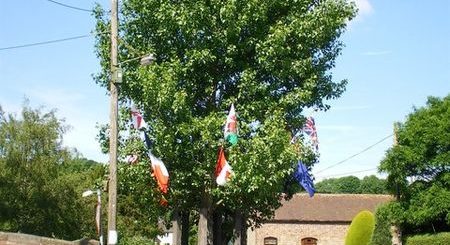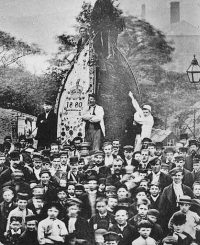Halloween / Samhain
31st October – The Samhain festival marked the end of summer and the beginning of winter in the Celtic calendar, and is one of the four Celtic fire festivals – the quarter points in the solar year. It marked the point in the year were a time of plenty gave way to more lean times, in all probability the reason for its association with dread and eeriness. Traditionally it is when the gates of the otherworld are open, a time when dark forces are abroad in the realm of humans.
In the old Celtic calendar Halloween – or more correctly Samhain – was actually the beginning of the New Year, and the preparation for the coming hardship of winter. All the animals that were not breeding stock were slaughtered, and their meat salted and stored for the dark months. As one of the most important celebrations of the year, a great feast was held, and bonfires were lit throughout the countryside.
 The festival was also a time when fertility played an important factor in the future well-being of a community. Animals were mated, and good breeding stock selected. This fertility aspect is reflected in legends passed down from the Celts. In Irish mythology the god Dhaghda made love to the Morrigan on Samhain eve, while she straddled the river Unius, in a symbolic union of the god of light and the goddess of death as the year turns towards darkness. Cu Chulainn also had Halloween relations, and Halloween was the date when Aengus found his otherworld maiden in the guise of a swan.
The festival was also a time when fertility played an important factor in the future well-being of a community. Animals were mated, and good breeding stock selected. This fertility aspect is reflected in legends passed down from the Celts. In Irish mythology the god Dhaghda made love to the Morrigan on Samhain eve, while she straddled the river Unius, in a symbolic union of the god of light and the goddess of death as the year turns towards darkness. Cu Chulainn also had Halloween relations, and Halloween was the date when Aengus found his otherworld maiden in the guise of a swan.
There may have been a more sinister side to the festival in Celtic times, and Caesar mentions human sacrifices during the four festivals of the year. Although Roman propaganda accounts can now be seen as biased, there is no smoke without fire, and evidence suggests ritual human sacrifice was practiced in the past. There is a tradition of the death of the sacrificial king at Samhain, and some of the darker customs of Halloween may disguise older practices. In some parts of Scotland, white stones marked to represent those present were thrown into the halloween fire, these had to be retrieved later, or evil was supposed to befall the person who could not find their stone. At Calander in Scotland, stones were placed in the ashes of the fire and left until morning. If they were displaced it spelt certain doom for the owner of the stone. Fraser in his book The Golden Bough, mentions the choosing of a sacrificial victim by the means of specially baked cakes, and in some regions small cakes were traditionally baked at Halloween; in England they were known as Soul cakes, eaten by all family members; and in Ireland they were known as barm brack cakes, which often contained lucky and unlucky objects of a divinatory nature.
The festival was also associated with the dead, and with remembering the ancestors. It was customary in some areas to leave an empty chair and a platter of foods for the invisible guests, so that they would not be offended. The witching hour was seen as the time when the departed returned, and silence was often kept for a short time in their honour – as the chimes of midnight rang out.
In the North of Scotland, Halloween was when the blue-faced hag of winter, the Cailleach Bheur was reborn with the coming of the winter snows. She was then the guardian of winter until the return of Summer on Beltane. She exists in many folk tales and may be a denuded form of a widely worshipped goddess. It was also customary to dedicate the last sheaf of corn from the harvest to her. This was moulded into a feminine shape and named the Carlin or the Cailleach.
With many of the rural communities entrenched in the old ways, the church decreed that November the 1st should be known as All Saints’ Day (this happened in 835AD), and All Souls’ Day was moved to the 2nd of November. Thus the 31st of October became All Saints’ Eve, or all Hallows’ Eve, with older customs and beliefs surviving until the present day.
The tradition of a bonfire celebration lasted longer in some rural areas than in others. At Fortingall in Perthshire, a fire was held on a Bronze Age burial mound until the early part of the 20th century. The local community danced around the fire while it was in full blaze, and then returned home for traditional Halloween games. This took place on the 11th of November, the time of Halloween (Samhain) in the old calendar.
Today the customs of Halloween are reflections on the deeper meaning of the festival to our ancestors. In the modern world, the changing of the seasons are not as important to our livelihood as it would have been hundreds of years ago, and the festival has become heavily commercialised. However, Halloween is great fun for thousands of children and will hopefully continue to be enjoyed, despite some calls from church leaders to have it banned.
Some Halloween Customs
In parts of Scotland it was customary to throw a silver coin through the front door of the house on the morning of November the 1st. The coin had to remain hidden where it had fallen to bring luck in money matters concerning the house.
The Halloween pumpkin originates from the custom of using lanterns to ward off the evil spirits, which were thought to wander through the thin veil into our world.
In some areas it was customary to throw a stone with a personal mark on it into the ashes of the fire. These had to be retrieved to ensure luck for the coming year.
If a young woman wanted to get a glimpse of her future husband, all she had to do was sit looking at her reflection in a mirror by candlelight at midnight, with an apple in her hand. Hopefully she would see the image of her future husband looking back at her from the mirror.
Hazelnuts were also used in husband divination, to denote a future love each of the nuts would be given the name of a possible lover and placed in front of the fire, the hopeful young lady would then recite “If you love me, pop and fly; and if you hate me burn and die.” The first nut to pop would be the girls’ likely suitor.
Another method of providing clues to a future spouse was to throw a fully peeled apple skin over the shoulder. This would then spell out the initial of her future lover.
Apples were also used in one of the better-known traditions that of Apple Bobbing. This game consisted of a large barrel of water in which a number of apples were floated, each participant then had to attempt to grab an apple using only their teeth, which inevitably led to a soaking. In another version, an apple and a lighted candle were placed on either end of a stick balanced in the middle and suspended from the ceiling by a piece of string. This was then spun, and those playing the game had to attempt to bite the apple without getting burned – a rather more painful fate than a good soaking!
The night was also a time for prophetic dreaming, again often to discover future husbands. This link with ongoing fertility may date back to when the festival was also a time for cattle to be mated for spring births.
As a time of change it was also a time of throwing out all the old associations that have passed their usage. On a personal level these were written down on a piece of paper and burned in an act of cleansing.
Some Halloween Hauntings
Halloween has always thought to be a good time to see the denizens of the spirit world, which is why few people ventured out of doors after dusk in more superstitious times. There are many hauntings that have a Halloween significance, some of these are listed below:
Spynie Palace, Morayshire
At Spynie Palace near Elgin -now a ruin – the bishop was thought to be a practitioner of black magic, and it was at Halloween when the local witches were said to fly to St David’s Tower filling the air with unearthly music and light.
Minsden Chapel, Hertfordshire
At Minsden Chapel in Hertfordshire the ghost of a monk is said to walk through the ruined arch, heralded by the peel of a bell.
Newton Castle, Perthshire
The apparition of the Green Lady of Newton Castle is said to be most likely to appear at Halloween, her gravestone is also meant to turn around three times.
Armboth House and Thirlmere Lake, Cumbria
Armboth House was haunted following the drowning of the household’s daughter on Halloween, the night before her wedding day. The house now lies submerged beneath Thirlmere resevoir, but it is said that the sound of bells can still be heard, and a ghostly dog is said to swim in Thirlmere Lake (where she was murdered).
Cliviger Gorge, Lancashire
A ghostly huntsman and his hound are said to appear.
References
Folklore Myths and Legends of Britain, Readers Digest
What Witches Do, Stewart Farrar
Celtic Gods and Goddesses, R. J. Stewart
The Golden Bough, James Frazer
Fire Festivals, A. McLean
English Festivals, L. Whistler
Practical Magic in the Northern Tradition, Nigel Pennick




Re: Halloween / Samhain
This is a good link from the New York Times 1892: http://graphics8.nytimes.com/packages/pdf/topics/halloween.pdf